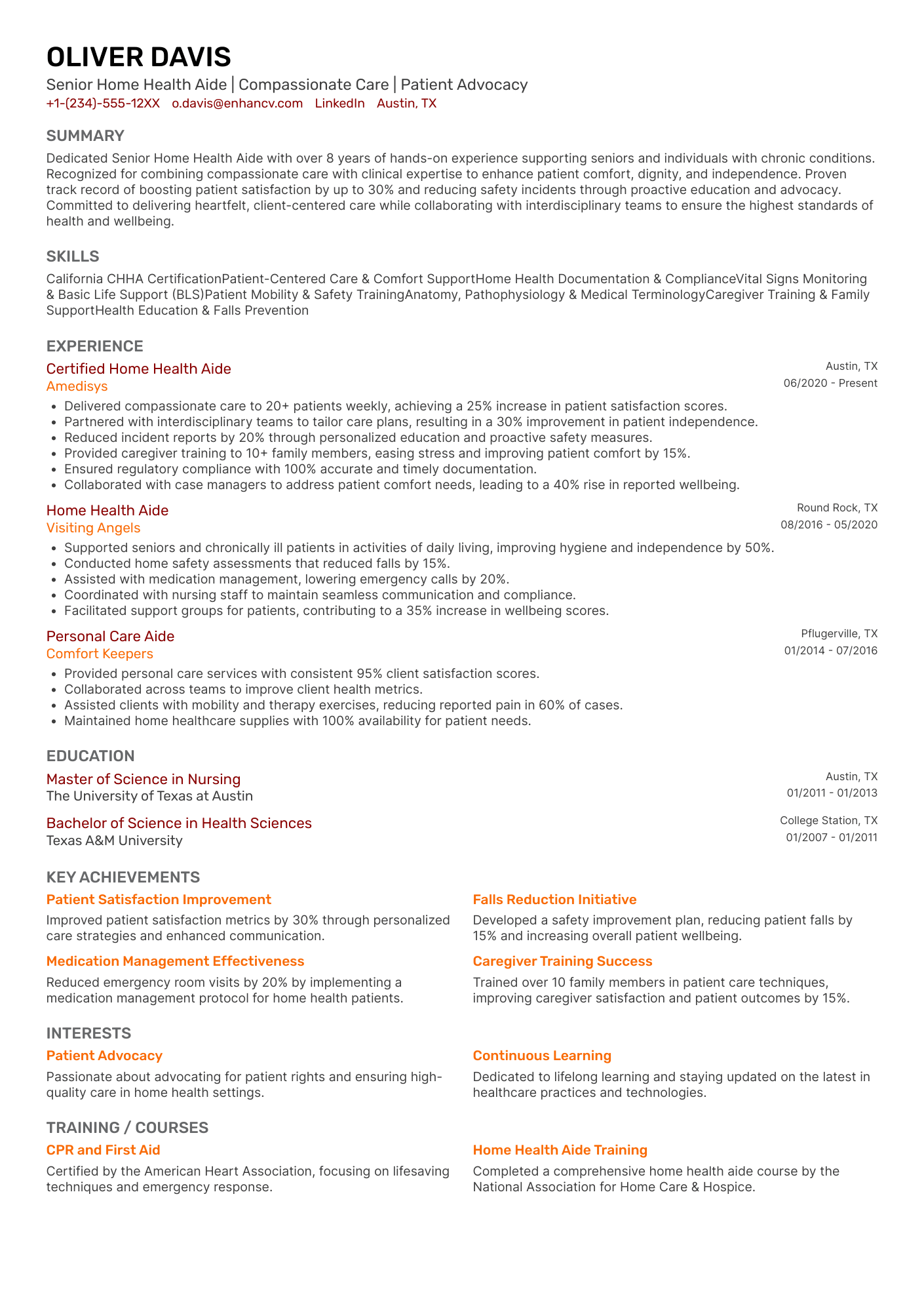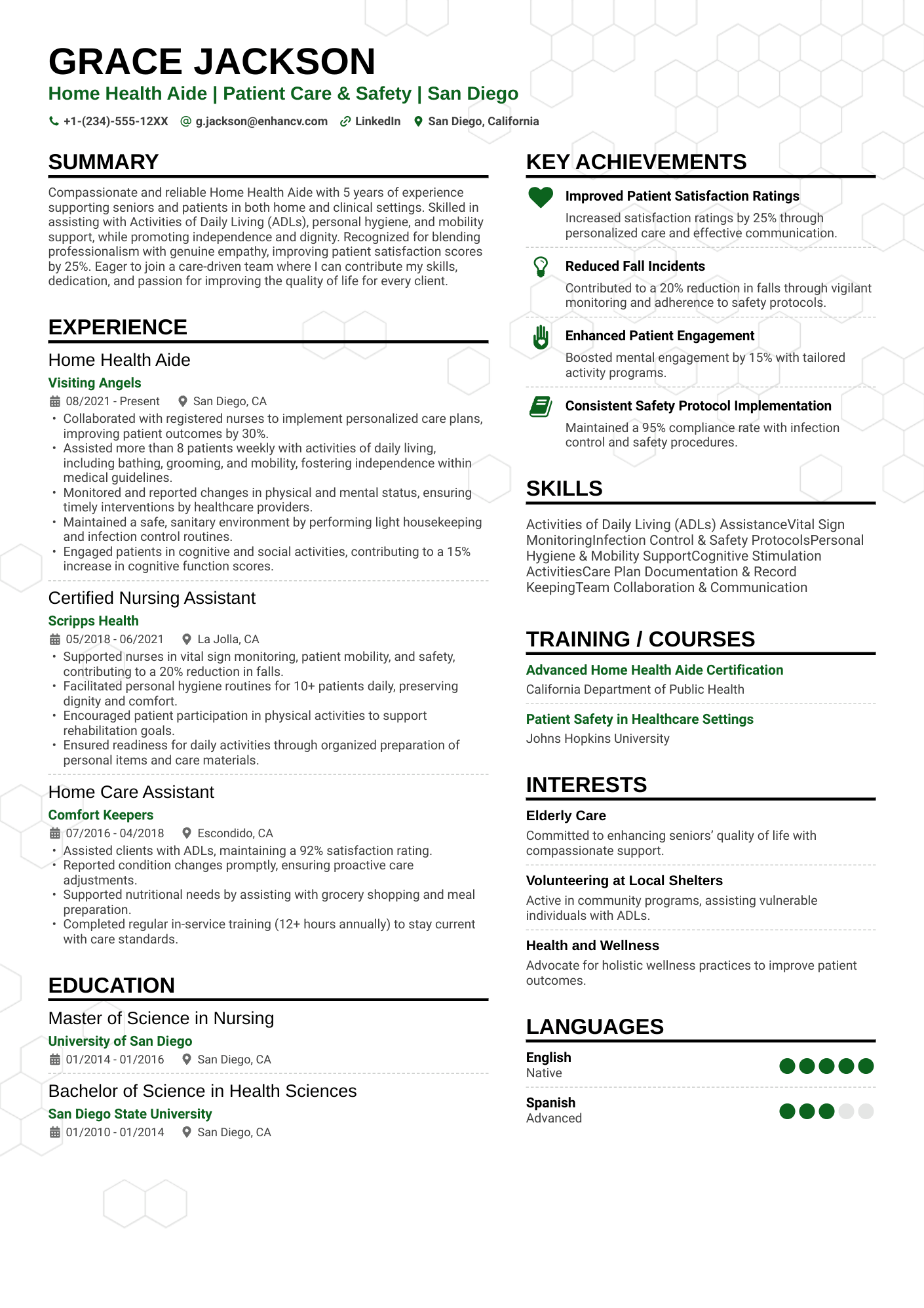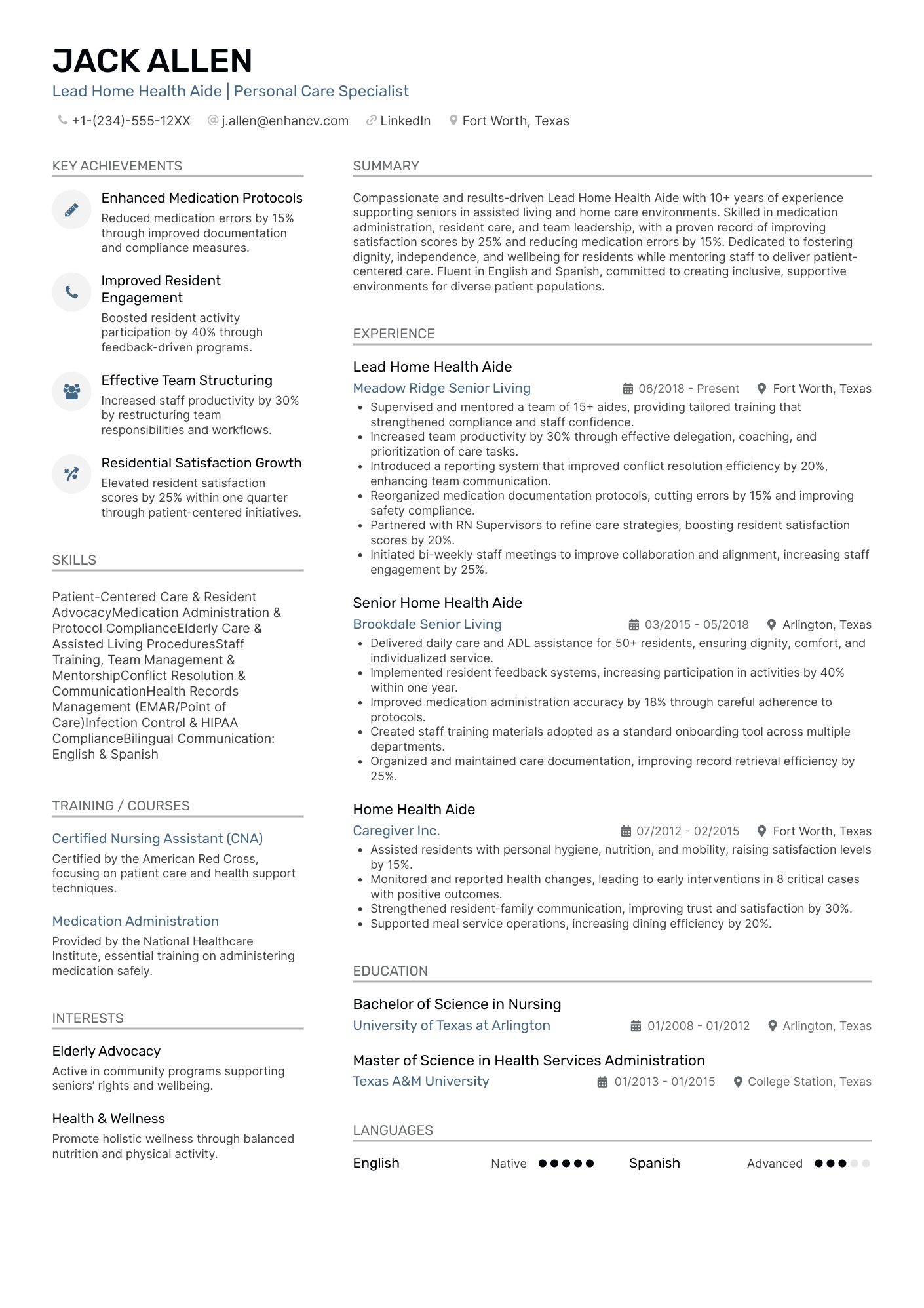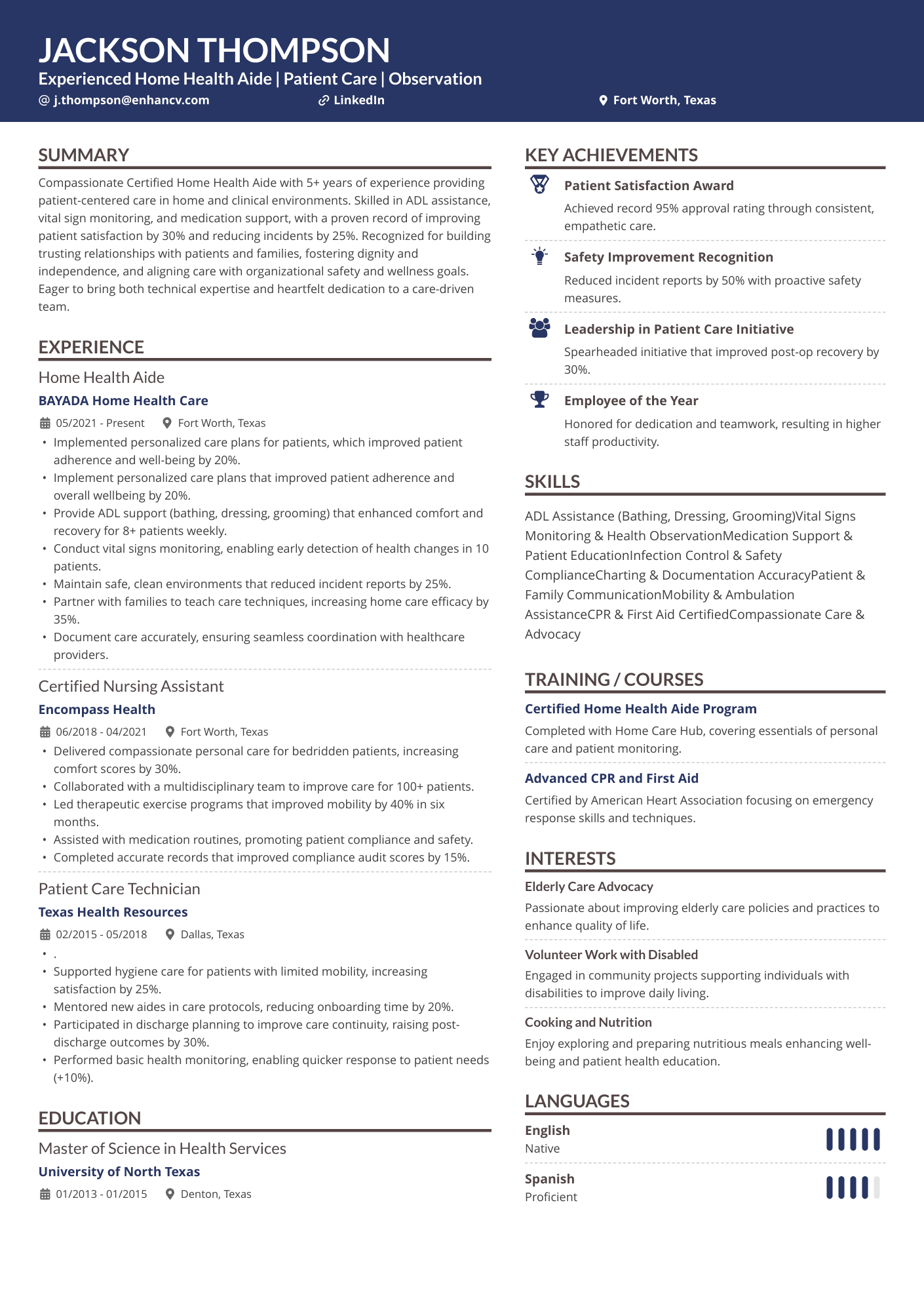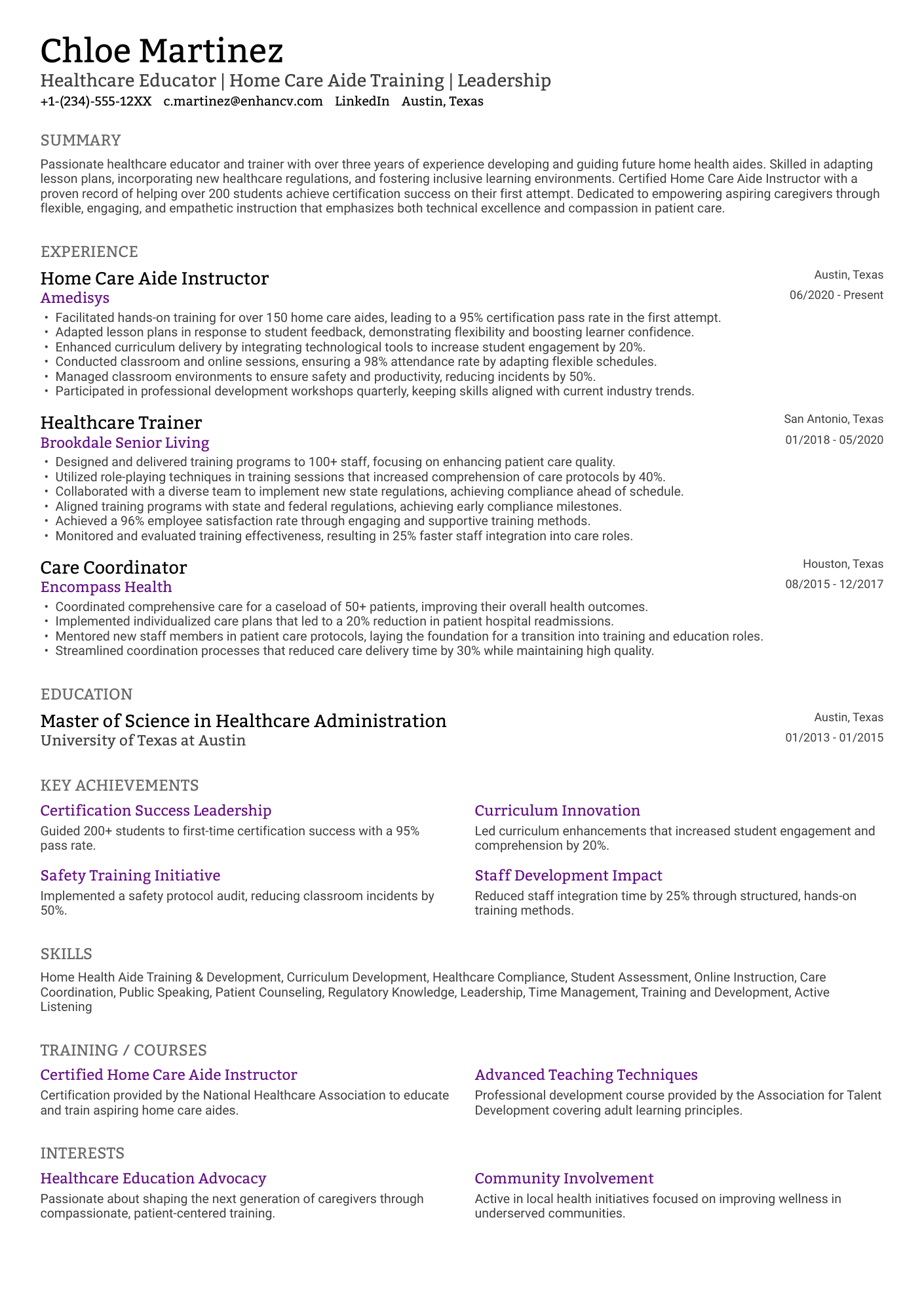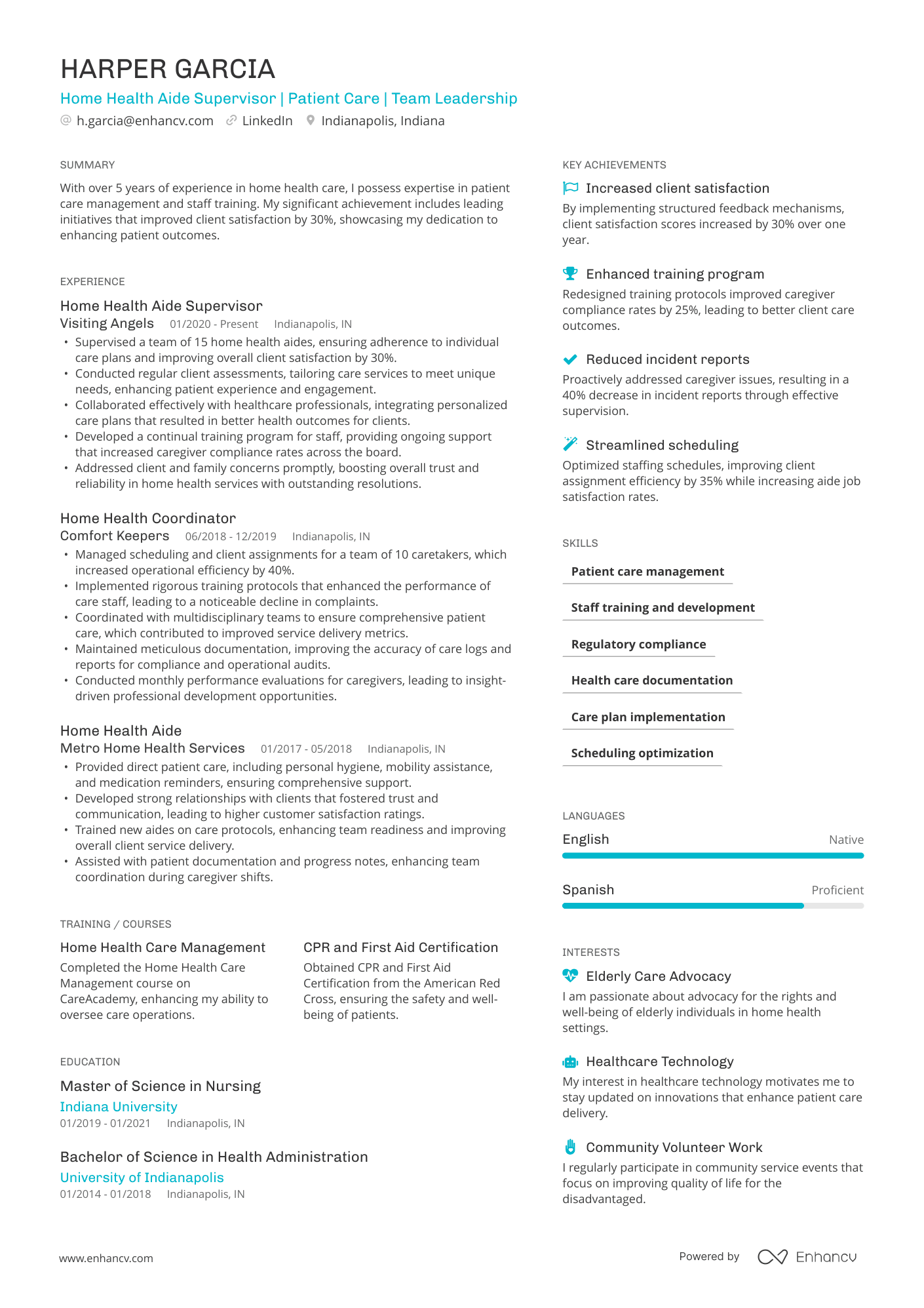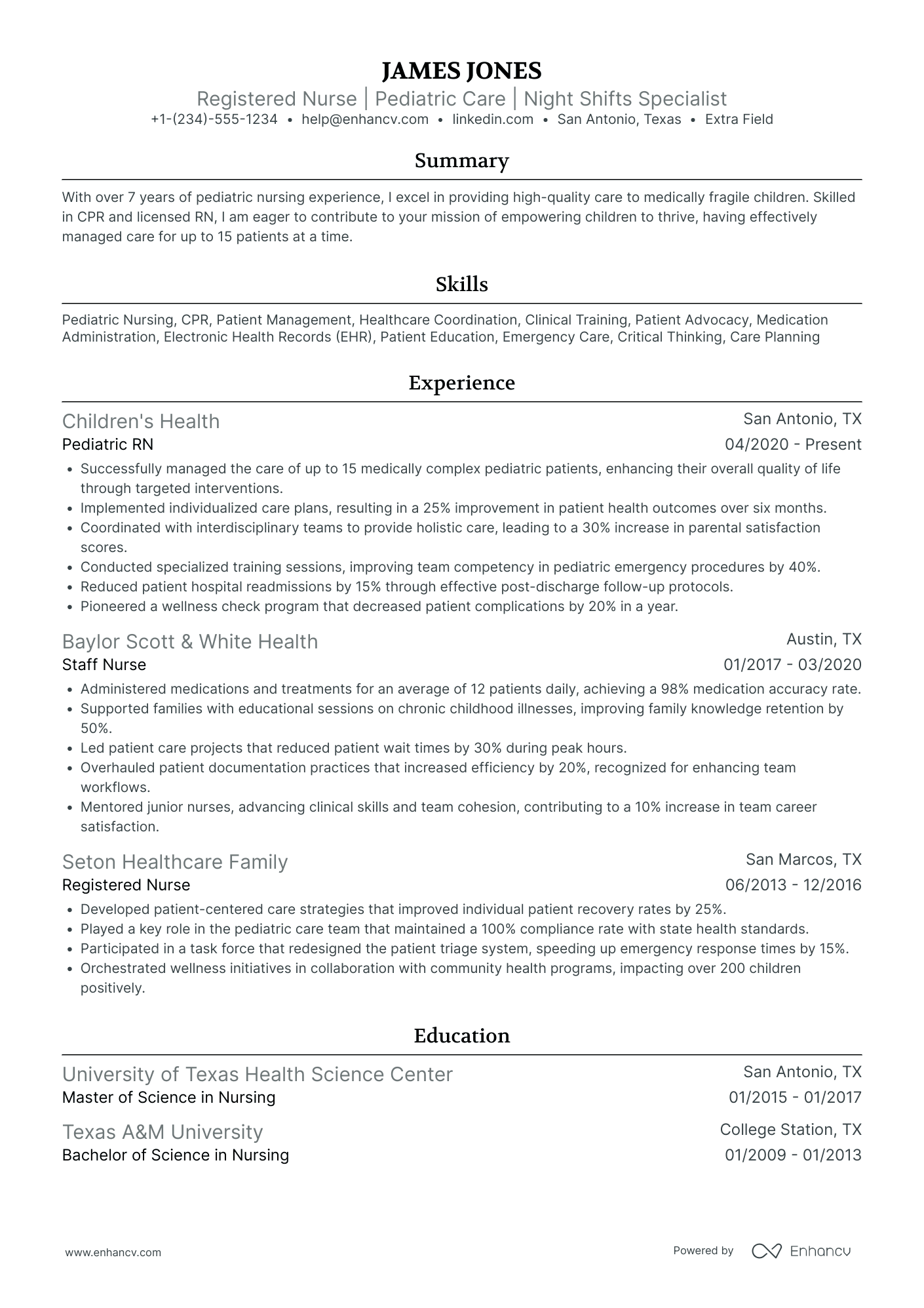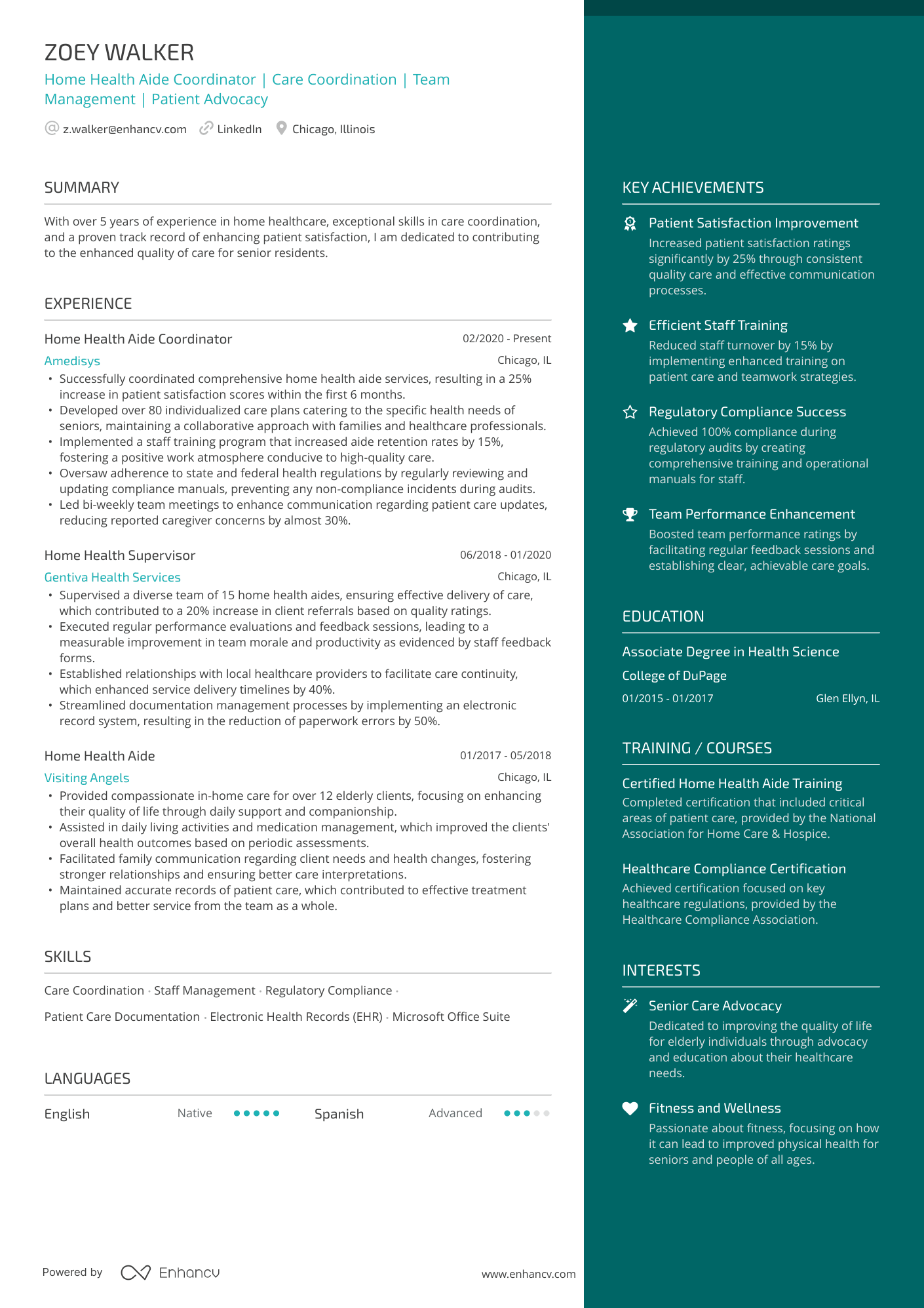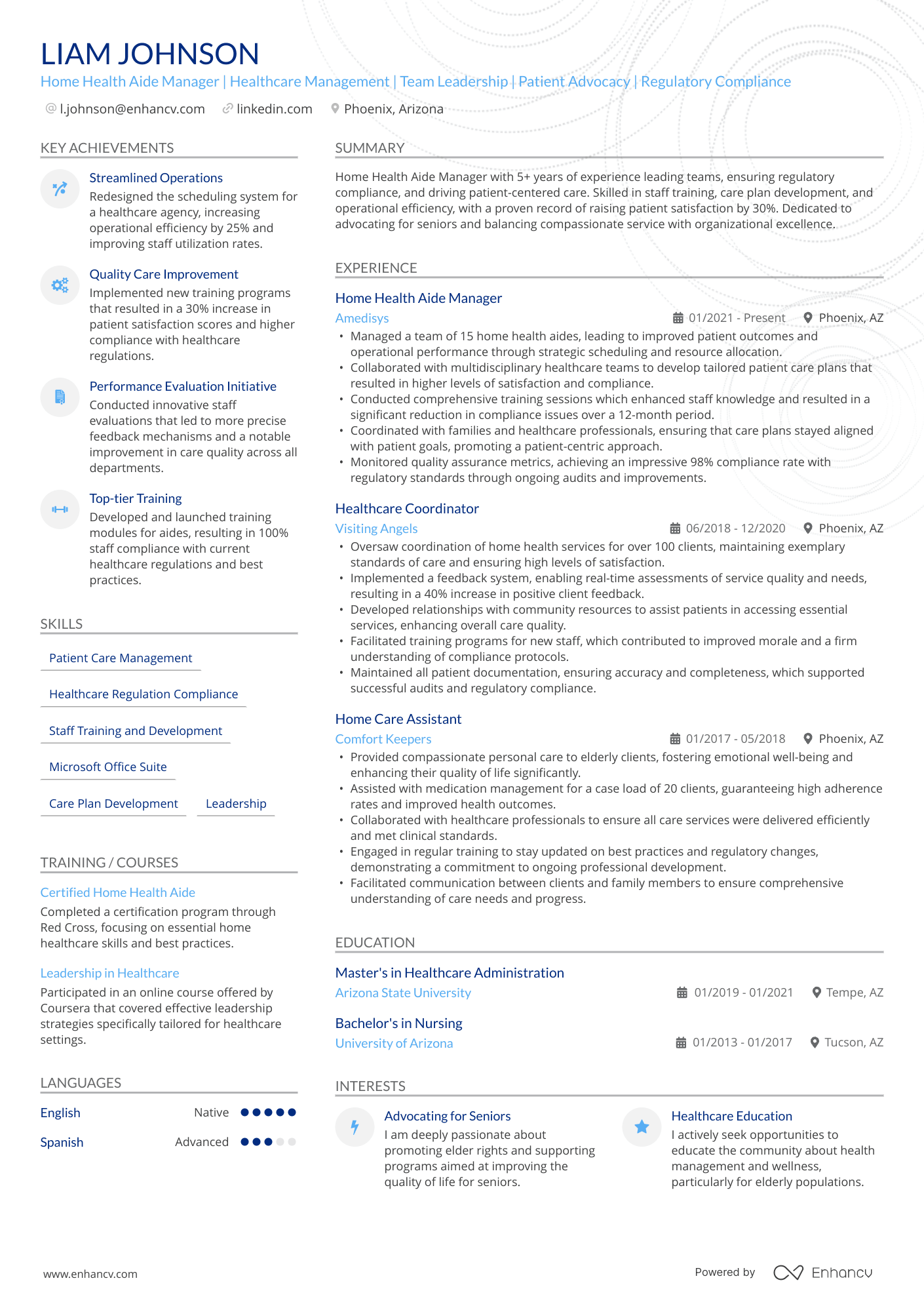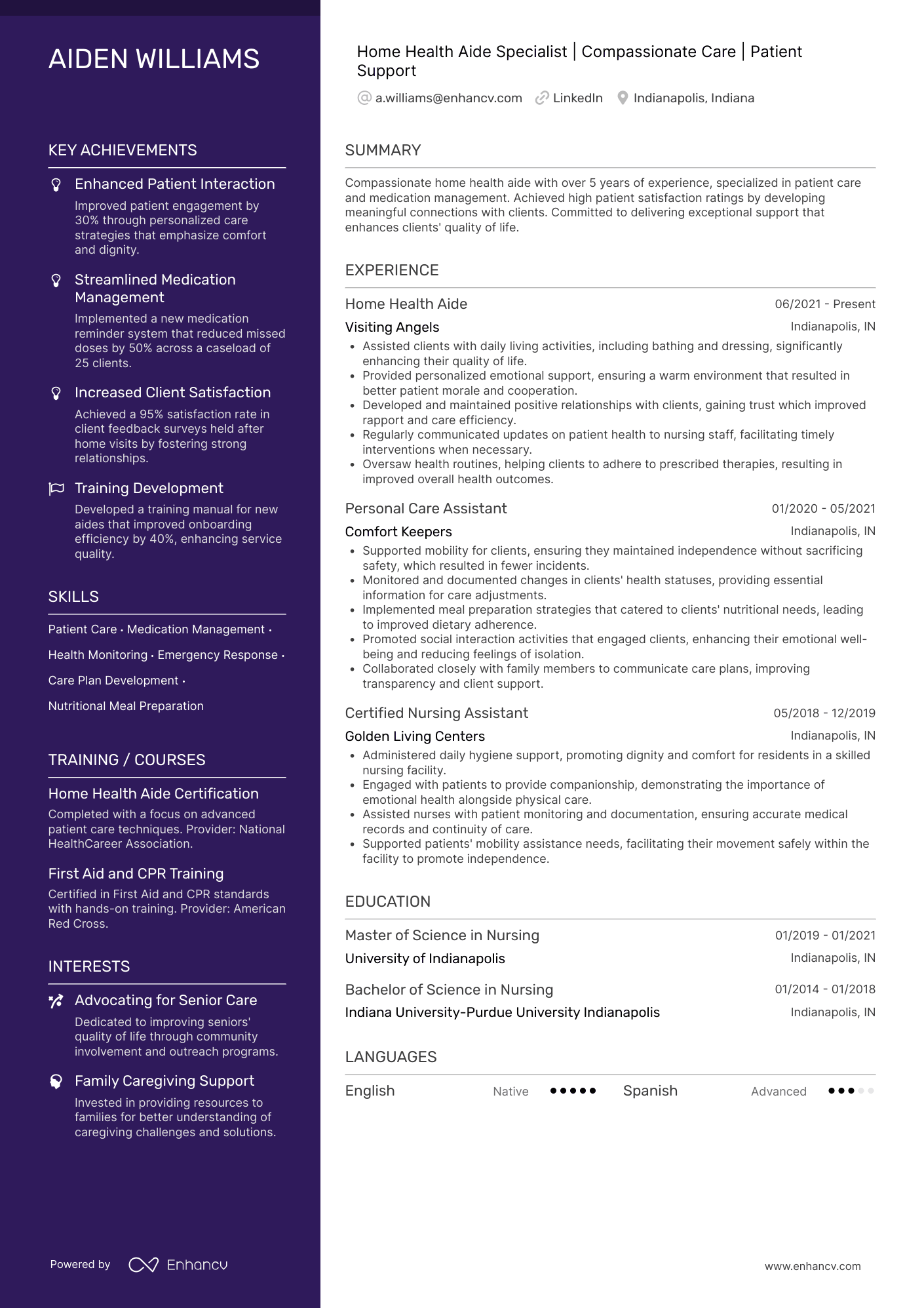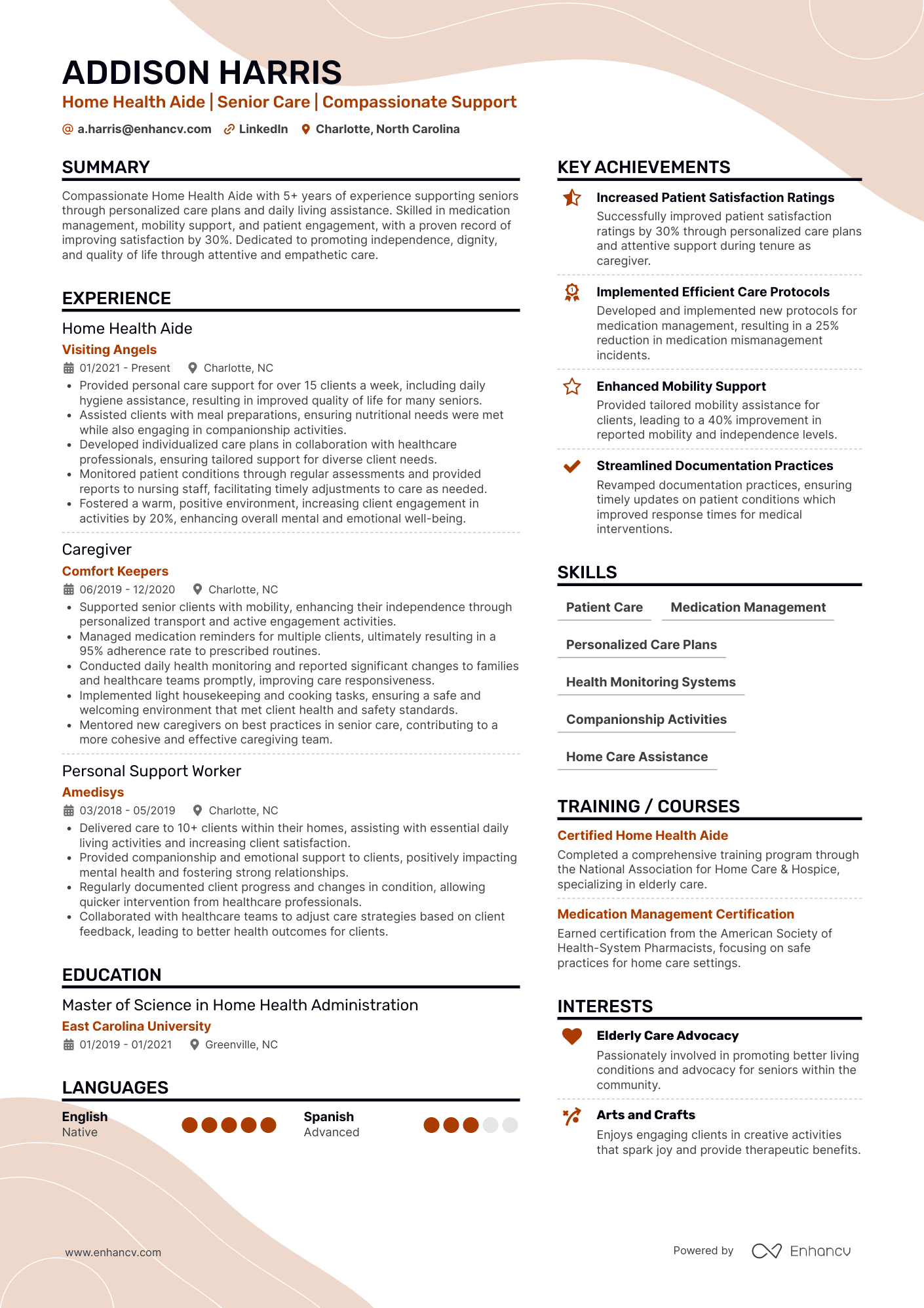Writing a resume as a home health aide isn’t always easy. You spend your days lifting patients, preparing meals, and offering comfort—yet putting that care into “resume language” can feel impossible. Many HHAs worry their work sounds routine, or that employers won’t see the value of their compassion and dedication.
The truth is, hiring managers want to know two things: can you provide safe, reliable care, and can families trust you? That’s why your resume should do more than list duties—it should highlight certifications, show the impact of your care, and reflect the empathy that sets you apart.
As Certified Professional Résumé Writers, we know the challenges HHAs face when trying to capture their skills on paper. That’s why we created this guide: to help you present your best self and build a resume that shows the true value you bring to every patient.
Key takeaways
- Use a reverse-chronological format to highlight recent experience and certifications.
- Include all essential sections: header, summary, work experience, education, certifications, and skills.
- Balance hard and soft skills—technical caregiving abilities and compassion are equally important.
- Quantify your impact with numbers (e.g., patients cared for, reduced hospital readmissions, satisfaction rates).
- Tailor your resume to each job description using relevant keywords and measurable achievements.
- Certifications often matter more than degrees—so make them easy to spot.
- Even without direct experience, highlight training, volunteer work, and transferable skills.
Home Health Aide resume examples
By Experience
Senior Home Health Aide
- Commitment to caregiving – A strong Senior Home Health Aide resume highlights both compassion and professionalism, reflecting a genuine dedication to supporting the wellbeing and dignity of seniors. It shows how the candidate’s career path and values align with making a meaningful impact in clients’ lives, ensuring their motivation is clear to employers.
- Engaging introductory summary – The opening section should immediately capture attention by emphasizing the applicant’s experience, reliability, and specialized skills in senior care. This creates confidence in the candidate’s readiness to take on advanced responsibilities.
- Balance of warmth and professionalism – The overall tone should blend empathy and client-centered enthusiasm with proven ability to manage sensitive situations with poise. This balance reassures employers of the aide’s technical competence as well as their dedication to creating a respectful, supportive environment for seniors.
Entry-Level Home Health Aide
- Eagerness and readiness stand out – A strong entry-level Home Health Aide resume concludes with a clear statement of enthusiasm to join a care-focused team. Adding a call to action such as “Eager to contribute to your organization and make a meaningful difference in clients’ daily lives” leaves a lasting impression and demonstrates a proactive, motivated mindset.
- Professional yet warm presentation – The overall tone should balance reliability and professionalism with compassion and empathy. This approach reassures employers that the candidate not only has the technical skills to succeed but also the interpersonal qualities essential to building trust and delivering quality care.
- Industry-specific language signals competence – Using terms like ADL assistance, vital sign monitoring, and infection control conveys familiarity with core responsibilities. This vocabulary demonstrates readiness to step confidently into the role while reinforcing alignment with healthcare standards and expectations.
Lead Home Health Aide
- Clear alignment with organizational mission – A strong Lead Home Health Aide resume demonstrates understanding of the employer’s care philosophy, commitment to patient-centered service, and support for staff development. Referencing these values shows genuine interest in the role and readiness to contribute to the organization’s unique environment.
- Purpose-driven personal motivation – The resume becomes compelling when it highlights authentic motivation, such as a dedication to improving the lives of seniors or a passion for mentoring and developing other caregivers. This sense of purpose communicates authenticity, engagement, and long-term commitment to the profession.
- Specialized skills and achievements showcased – What sets an applicant apart is the ability to present distinctive expertise and measurable accomplishments, such as leading successful care transitions, implementing innovative medication protocols, or leveraging bilingual skills to serve diverse populations. These details reinforce added value and demonstrate readiness for leadership in senior care.
By Role
Certified Home Health Aide (CHHA)
- Authentic empathy and compassion – A standout Certified Home Health Aide resume highlights heartfelt dedication to client well-being, going beyond routine tasks to show meaningful impact. Personal touches—such as examples of fostering patient dignity, easing family stress, or supporting independence—demonstrate genuine care and connection.
- Confident yet uplifting presence – The language should convey both competence and optimism, balancing professional reliability with enthusiasm for making a positive difference. This tone reassures employers that the candidate can provide safe, effective care while also uplifting the spirits of clients and their families.
- Alignment with organizational mission – Effective resumes reflect awareness of the employer’s philosophy, whether through references to patient-centered care, safety initiatives, or staff collaboration. This alignment signals genuine interest in contributing to the company’s unique goals and values.
Home Health Aide Trainer
- Flexibility in teaching and training – A standout Home Health Aide Trainer resume highlights the ability to instruct diverse groups, adapt lesson plans in response to feedback, and incorporate evolving healthcare regulations. This flexibility demonstrates readiness to pivot within a dynamic care and education environment.
- Clear progression toward professional training – The strongest resumes show a natural evolution from caregiving or patient care roles into training and leadership. By connecting prior hands-on experience with mentoring and educational responsibilities, candidates establish credibility in both caregiving and adult education principles.
- Authentic empathy and connection to caregiving – Through carefully chosen language and accomplishments, the resume should radiate compassion and a genuine dedication to empowering future aides. Demonstrating a personal commitment to improving patient care ensures employers see not only technical expertise but also heartfelt motivation.
Home Health Aide Supervisor
- Leadership rooted in patient-centered care – A strong Home Health Aide Supervisor resume highlights the ability to oversee teams while keeping client wellbeing at the core. Demonstrating how supervisory practices directly improve patient outcomes reassures employers that leadership is guided by compassion as much as efficiency.
- Commitment to staff development and quality improvement – Employers look for candidates who not only manage but also mentor. By showcasing achievements in training, compliance, and reducing incident reports, the resume signals a dedication to cultivating skilled, reliable caregivers who deliver consistent, high-quality service.
- Proven ability to optimize operations – What distinguishes a supervisor is the capacity to enhance both care and efficiency. Demonstrating accomplishments such as streamlining scheduling, improving satisfaction scores, or boosting compliance rates highlights readiness to balance organizational goals with patient trust and comfort.
Pediatric Home Health Aide
- In-depth clinical experience sets a strong foundation – Highlighting hands-on expertise in providing direct care to pediatric patients, especially noting certifications like CPR, medication administration, and specialized care for children with chronic conditions, demonstrates deep professional competence tailored to the unique demands of pediatric home healthcare.
- A unified personal brand communicates reliability and compassion – Maintaining a consistent narrative across the resume and LinkedIn profile that emphasizes empathy, dedication, and adaptability reinforces the impression of a candidate genuinely committed to high-quality pediatric care, which resonates strongly with both families and employers seeking trustworthy aides.
- Immediate suitability is evident through organizational clarity – A resume that is well-structured, clear, and free of clutter, with a focus on pertinent skills and achievements, gives a positive first impression, signaling that the applicant is both detail-oriented and fully prepared for the sensitive and dynamic nature of pediatric home health support.
Home Health Aide Coordinator
- Strength in care coordination – A standout Home Health Aide Coordinator resume demonstrates the ability to align patient needs, family expectations, and staff performance into seamless care delivery. Highlighting accomplishments such as improved satisfaction scores and effective communication strategies shows the candidate’s capacity to bring structure and compassion together.
- Commitment to team development and retention – Employers value coordinators who foster positive work environments. By showcasing achievements in staff training, retention, and performance enhancement, the resume conveys dedication to building reliable, motivated teams that deliver consistent, high-quality care.
- Proven compliance and operational excellence – Effective coordinators ensure regulations and standards are met without compromising patient dignity or staff morale. Demonstrating success in regulatory audits, electronic health record management, and streamlined processes reinforces readiness to balance operational efficiency with patient advocacy.
Home Health Aide Manager
- Leadership with measurable impact – A standout Home Health Aide Manager resume highlights the ability to oversee teams, implement training programs, and strengthen operations. By presenting concrete results such as higher patient satisfaction and improved compliance, it shows how leadership directly enhances care quality.
- Balance of compliance and compassion – Employers look for managers who can ensure regulatory standards are met while keeping patient dignity and advocacy at the center of care. Demonstrating this balance signals both reliability and genuine commitment to senior wellbeing.
- Operational excellence through innovation – What sets strong candidates apart is evidence of system improvements—such as streamlining scheduling, boosting staff performance, or developing new evaluation methods. These achievements reassure employers of readiness to lead efficient, patient-centered home healthcare services.
Home Health Aide Specialist
- Emphasis on compassionate, individualized care – A strong Home Health Aide Specialist resume highlights the ability to deliver personalized support that enhances comfort, dignity, and independence. Demonstrating success in building meaningful patient relationships shows genuine dedication to improving quality of life.
- Balance of technical expertise and emotional support – Employers value candidates who pair proficiency in patient monitoring, medication management, and care planning with empathy and companionship. This combination signals readiness to meet both the medical and emotional needs of clients.
- Proven record of improving outcomes – What sets standout resumes apart is measurable impact, such as reducing medication errors, improving adherence to care routines, or raising patient satisfaction scores. These achievements reassure employers of both reliability and effectiveness in supporting vulnerable populations.
Home Health Aide Caregiver
- Compassion as the foundation of care – A strong Home Health Aide resume highlights empathy, patience, and genuine dedication to improving seniors’ daily lives. Demonstrating how compassionate support translates into measurable improvements in satisfaction and wellbeing shows the candidate’s ability to go beyond routine tasks.
- Balance of practical skills and emotional support – Employers look for aides who can combine essential caregiving functions such as medication management, mobility assistance, and health monitoring with companionship and encouragement. This dual focus assures families and organizations that both physical and emotional needs are met.
- Evidence of measurable impact – Standout resumes emphasize concrete achievements such as improving satisfaction ratings, enhancing mobility, or reducing medication mismanagement. These results provide assurance of both competence and commitment to quality care in home health environments.
How to choose the best resume format for a home health aide
For home health aides, the right resume format should put your most recent experience and certifications front and center. This will help hiring managers quickly see the caregiving skills and reliability you bring to the job.
That’s why we recommend using the reverse-chronological format.
Exception:
If you’re changing careers, have some gaps, or are at the beginning of your career, a functional or hybrid format could work better—these favor skills over experience.
What sections should go on a home health aide resume?
Recruiters want to see that you’re skilled, dependable, and compassionate—the essentials for any home health aide.
To make that clear, structure your resume with these sections in order:
- Header (contact info)
- Resume summary
- Work experience
- Education and certifications
- Skills
PRO TIP
Because trust is so important in caregiving, a recommendation or a reference can really strengthen a home health aide resume.
The best way to include one is as a short quote in your sidebar—for example, “Provided compassionate daily care for my father with dementia”—or as a simple note at the bottom of your resume: “References available upon request.”
If you have particularly strong endorsements from supervisors or families, you could even add a small “Recommendations” section after Skills or Achievements.
Use our AI Resume Builder to create a resume that caters to your unique scenario.
For home health aides, a one-column resume is a safe choice—it’s simple, professional, and easy for ATS to scan. A two-column format can also work if used carefully, giving you space to highlight skills, certifications, or even a short recommendation in a sidebar. The key is keeping the layout clean and clear, since healthcare employers value clarity above all else.
If you’re using a two-column template, place shorter sections like Skills, Education, or your References links in the narrower column while keeping the overall order easy to follow left to right. Enhancv’s resume templates include creative options which balance readability with a personal touch.
Already have a resume? Run it through Enhancv’s Resume Checker to get a score on your document and tailored suggestions that’ll make your application skyrocket!
Is your resume good enough?
Drop your resume here or choose a file. PDF & DOCX only. Max 2MB file size.
How to write your home health aide resume experience
Your work experience should clearly tell employers that you can be trusted with patient care and daily responsibilities. Hiring managers want to see who you’ve worked for, the type of care you’ve provided, and the positive impact you’ve made on patients’ lives.
Make sure each entry includes:
- Job title and employer: Be clear if you are a Certified Home Health Aide, Personal Care Aide, or Senior Caregiver. Each signals a different level of responsibility.
- Dates of employment: Show a clear timeline with consistent formatting. For example, use the month and year for both the start and the end date, or alternatively, just the year.
- Location: City and state, or note “Private Residence” if applicable.
To describe your duties, use three to six bullet points that contain:
- Scope of care: Patient age group, health conditions, and/or number of clients served.
- Tasks and skills: Examples include bathing, grooming, mobility assistance, meal prep, vital signs monitoring, and medication reminders.
- Collaboration: Worked with nurses, doctors, and/or family members to coordinate care.
- Results/impact: Improved patient comfort, reduced hospital readmissions, and/or helped clients maintain independence.
Here’s an example:
Good example of a home health aide experience section
Home Health Aide
BrightCare Agency | Boston, MA
Jan 2021–Jun 2024
- Delivered daily personal care to 12+ elderly clients, consistently meeting all state health and safety standards.
- Monitored and recorded vital signs 500+ times per month, ensuring timely communication of health changes to nurses and physicians.
- Assisted in reducing hospital readmissions by 18% by following individualized care plans and maintaining strict medication reminders.
- Developed dementia care routines that lowered patient agitation episodes by 30%, improving quality of life for 4 long-term clients.
- Trained and mentored 5 new aides, resulting in faster onboarding and higher consistency in care delivery.
- Achieved 97% family satisfaction rate according to quarterly client feedback surveys.
In this example, we’ve highlighted quantifiable achievements—these metrics clearly show the real impact of a home health aide’s work and make the resume more convincing to employers.
Basically, whenever you’re unsure of how to structure your bullets, use this technique:
PRO TIP
The C-A-R Method for successful resume bullets
- C=Challenge: What was a major challenge you faced when you took this position?
- A=Action: What action did you take to meet the challenge?
- R=Result: What, in as quantifiable terms as possible, was the result of your actions?
How to tailor your home health aide resume experience
As a caregiver, you know every patient has unique needs. The same goes for your application. Tailoring your resume to the job posting shows employers you can respond to different situations and deliver exactly the care they’re looking for.
Here are several ways to target the job posting through your experience section:
- Highlight the type of care the role emphasizes (elderly care, dementia support, post-surgery recovery, or pediatric patients).
- Reference keywords from the job posting, such as “vital signs monitoring,” “mobility assistance,” or “medication reminders.”
- Point out experience with similar patient loads or care environments (private homes, assisted living facilities, or hospice).
- Show collaboration with professionals the role involves—nurses, doctors, therapists, or family caregivers.
- Back up your work with measurable outcomes the employer values, like reduced hospital readmissions, improved patient satisfaction, or consistent safety compliance.
Resume tailoring examples for home health aides
Job description excerpt:
Experience assisting seniors with daily living tasks and mobility support
Untailored bullet
Helped patients with daily activities
Tailored bullet
Assisted 10+ senior clients daily with bathing, grooming, and mobility support, helping maintain independence and dignity.
Why This Works
- Uses JD keywords (“seniors,” “mobility support”)
- Quantifies scope of work (“10+ clients daily”)
- Shows patient-centered impact (“maintain independence and dignity”)
Resume tailoring examples for home health aides
Job description excerpt:
Ability to monitor vital signs and report changes to medical staff.
Untailored bullet
Checked patient health regularly.
Tailored bullet
Monitored vital signs 20+ times per week and reported irregularities to supervising nurses, preventing 3 potential hospitalizations.
Why This Works
- Directly matches the job description skill.
- Adds numbers to show scope of responsibility.
- Highlights real outcomes that demonstrate impact.
Resume tailoring examples for home health aides
Job description excerpt:
Proven teamwork with healthcare providers and family members.
Untailored bullet
Worked with nurses and families.
Tailored bullet
Partnered with 4 nurses and 6 family caregivers to follow individualized care plans, ensuring consistent patient well-being.
Why This Works
- Mirrors the collaboration emphasized in the job description.
- Quantifies relationships to add credibility.
- Demonstrates clear coordination and follow-through.
PRO TIP
The short truth about ATS
Tailoring your resume is important for both the ATS software and the human eye. Even after machine screening, a recruiter or a hiring manager will always review your application.
Applicant tracking systems don’t automatically reject resumes. What matters is clarity. Use simple fonts, consistent dates, standard section titles, and—most importantly—the right caregiving keywords from the job description (like vital signs monitoring, mobility support, or dementia care).
You also don’t need to reinvent your resume for every single application. With Enhancv’s One-Click Tailoring Tool, just paste in the job description and you’ll get targeted suggestions for bullet points, skills, and achievements. It’s an easy way to show employers you’re a strong fit while keeping your caregiving strengths front and center.
How to quantify your experience on a home health aide resume
Caregiving may feel personal and hands-on, but numbers help employers see the real scope of your impact. Quantifying your achievements shows the difference you made—how many patients you supported, how often you monitored health indicators, or even how your care improved patient well-being. These metrics prove that you’re not only compassionate, but also effective and results-driven.
Examples of how to quantify home health aide achievements
| How to quantify | Example bullet point |
|---|---|
| Show how many patients or clients you cared for | Assisted 12 elderly clients daily with personal care and mobility support, maintaining a 95% client satisfaction rate. |
| Highlight frequency of key tasks | Monitored and recorded vital signs 100+ times per month, ensuring accurate updates to supervising nurses. |
| Point out health or safety improvements | Reduced hospital readmissions by 18% by following care plans and ensuring medication compliance. |
| Mention recognition or feedback received | Earned consistent praise from families and received Employee of the Month three times for reliability and compassion. |
| State how your efforts improved efficiency | Trained 5 new aides, cutting onboarding time by 30% and raising team consistency in care delivery. |
How to list your hard and soft skills on your home health aide resume
Hiring managers want to see that you bring the full package: the hard skills to carry out essential caregiving tasks and the soft skills to provide comfort, patience, and trust.
For home health aides, both are equally important. Hard skills prove you can handle the medical and daily care responsibilities every HHA must master, while soft skills show you can connect with patients and families in a supportive, reliable way.
That’s why your skills section should be clear and easy to find. List your hard skills in a dedicated section, and let your soft skills shine through your summary and experience bullets—where you can back them up with real examples of compassionate care.
Best hard skills for your home health aide resume
- Patient personal care (bathing, grooming, feeding)
- Mobility support (transfers, wheelchair assistance)
- Vital signs monitoring (blood pressure, temperature, pulse)
- Medication reminders and record-keeping
- Infection control and safety compliance
- Specialized care (dementia, Alzheimer’s, post-surgical recovery)
- First Aid & CPR
- Meal preparation and nutrition support
Best soft skills for your home health aide resume
- Empathy and compassion
- Patience under pressure
- Active listening and clear communication
- Time management across multiple clients
- Adaptability to patient needs and conditions
- Reliability and trustworthiness
- Problem-solving in emergencies
- Collaboration with families and healthcare teams
Example of weaving soft skills into your experience or summary
- Summary:Compassionate home health aide with 5+ years of experience supporting elderly and post-surgical patients. Known for combining strong caregiving skills with patience and empathy, consistently praised by families for reliability and professionalism.
- Experience bullet:Assisted 10+ seniors daily with personal care and mobility, demonstrating empathy, patience, and strong communication with both patients and families.
How to list your certifications and education on your home health aide resume
Education and certifications give recruiters a quick snapshot of the foundation behind your caregiving skills. In healthcare, formal training and up-to-date certifications are just as important as hands-on experience. Employers want to know you’ve met state requirements and that you keep your knowledge current through continuing education.
Here’s what to include in an education resume entry:
- Degree or program completed (if applicable)
- School, training center, or adult education provider
- Location
- Graduation year (month optional)
- Relevant coursework or honors (helpful if you’re new to the field)
For home health aides, certifications usually carry more weight than formal degrees. Most employers require at least a high school diploma or equivalent, but what really makes you employable are the state-approved certifications that prove you’re trained to provide safe care.
- Education gives you the baseline: a high school diploma, GED, or sometimes vocational coursework in healthcare.
- Certifications show you’re qualified: like HHA, CNA, CPR/First Aid, dementia care, or hospice training.
If you have higher education (like an associate degree in healthcare), list it. But always make sure your certifications are easy to spot—recruiters will look for them first.
In your certification resume section, make sure to add:
- The exact certification title
- The organization or state agency that issued it
- The year earned (plus expiration date if it applies)
Example of an education or certifications section for a home health aide
Certifications
- Certified Home Health Aide (HHA), Massachusetts Department of Public Health, 2021
- CPR & First Aid, American Red Cross, 2023 (expires 2025)
- Dementia Care Training, Alzheimer’s Association, 2022
Education
High School Diploma, 2018
Boston High School | Boston, MA
Best certifications for your home health aide resume
If you’re just starting out or changing careers:
- Home Health Aide (HHA) Certification: meets state requirements for caregiving roles
- Certified Nursing Assistant (CNA): a great step for those who want to expand their responsibilities
- CPR & First Aid (American Red Cross, American Heart Association): essential safety training
For designers with mid-level experience:
- Medication Aide Certification: allows you to assist with or administer medications in some states
- Dementia/Alzheimer’s Care Certification: demonstrates expertise with specialized patient groups
- Palliative or Hospice Care Training: valuable for roles in end-of-life care
For specialized roles:
- Bilingual Caregiver Training: strengthens resumes for agencies serving diverse communities
- Nutrition & Meal Planning Courses: highlights ability to support patients with dietary needs
- Infection Control Certification: particularly relevant post-pandemic, for safety-conscious employers
How to write your home health aide resume summary
The resume summary is the prime real estate of your application—an opportunity to show you’re both qualified and compassionate—two traits every employer looks for in a home health aide. This short section is often the first—and sometimes the only—thing recruiters read, so make it count.
A strong summary should:
- State your current role and years of caregiving experience
- Highlight the types of patients you’ve supported (elderly, post-surgical, dementia, hospice)
- Mention key caregiving skills or certifications (CPR, HHA, CNA, dementia care)
- Include measurable achievements (e.g., patient satisfaction scores, reduced readmissions, number of clients supported)
- Emphasize what you bring to the employer—how you ensure safe, compassionate care.
- Aim for 3–4 sentences that combine your experience, skills, and impact into a compelling profile
Example summary:
Compassionate Home Health Aide with 6+ years of experience supporting elderly and post-surgical patients in private homes and assisted living facilities. Skilled in vital signs monitoring, mobility assistance, and dementia care, with certifications in CPR and First Aid. Consistently praised by families for reliability and empathy, achieving a 95% client satisfaction rate while helping patients maintain independence and dignity.
Here’s a recap of the formula this example follows:
- Who you are: compassionate Home Health Aide
- What you’ve done: 6+ years supporting elderly and post-surgical patients
- How you did it: skilled in monitoring, assistance, dementia care, certified in CPR/First Aid
- Result: 95% client satisfaction, patients maintain independence and dignity
Optimize your resume summary and objective for ATS
Drop your resume here or choose a file.
PDF & DOCX only. Max 2MB file size.
How do I write a home health aide resume with no experience?
Caregiving is one of those fields where empathy, reliability, and willingness to learn matter just as much as prior experience. Many agencies are open to hiring entry-level home health aides if you can show the right training, transferable skills, and dedication to patient care. Even without a formal work history, you can still craft a resume that proves you’re ready for the role.
What to include instead of work experience:
- Relevant coursework or training programs: State-approved Home Health Aide (HHA) or Certified Nursing Assistant (CNA) classes, CPR/First Aid, or dementia care workshops.
- Internships or part-time caregiving roles: Babysitting, elder care for a family member, or volunteering at a hospital or nursing home.
- Volunteer or extracurricular involvement: Community service, church groups, or support roles where you helped people with mobility, meals, or companionship.
- Certifications: CPR, First Aid, HHA/CNA training—these are often the first things recruiters look for.
- Extra sections: Add “Projects” or “Achievements” to showcase practical examples, like “Completed 40 hours of supervised patient care as part of HHA training program.”
Pair it with a cover letter
A thoughtful cover letter can make up for limited direct experience. Use it to highlight your training, volunteer work, and the personal qualities that make you suited for caregiving. Connect your motivation to the employer’s mission—for example, showing that you value helping patients maintain independence and dignity.
Drop your resume here or choose a file.
PDF & DOCX only. Max 2MB file size.
Frequently asked questions about home health aide resumes
Here are answers to common dilemmas candidates face:
What should your home health aide resume header include?
Your header should give recruiters everything they need to contact you quickly. Include your full name, phone number, professional email, city and state, and (optionally) your LinkedIn profile. Skip personal details like age or marital status—they aren’t needed.
What does a good home health aide resume look like?
A strong HHA resume is easy to scan. Use a legible font, well-spaced sections, and clear headings like “Experience” and “Certifications.” Stick to one page for most cases. You can go up to two pages if you have 10+ years of experience. Since caregiving is a serious field, avoid overly creative designs—clarity and professionalism matter most.
How should I name and format my resume file?
Always save your resume as a PDF to keep the layout intact, unless the job posting asks for another format. Use a clear, professional file name such as Firstname-Lastname-Resume.pdf. Avoid vague names like resume-final.pdf, which look sloppy and get lost in a recruiter’s folder.
How do I show career progression on a home health aide resume?
Employers want to see growth. If you’ve advanced from a trainee or volunteer to a certified aide, make that clear in your work history. Show promotions, additional certifications, or expanded responsibilities—for example, expanding from assisting one client to supporting multiple patients, or moving into dementia care.
Do I need industry-specific experience to land a home health aide role?
Not always. Many agencies and families welcome candidates with related experience, such as babysitting, volunteering at a nursing home, or caring for a relative—especially if you’ve completed HHA or CNA certification. What matters most is showing empathy, dependability, and the ability to follow care plans.
What should I include in a home health aide cover letter?
Your cover letter should complement your resume, not repeat it. Explain why you want to work in caregiving and give one example that proves your dedication—like supporting an elderly relative, completing HHA training, or volunteering with patients. Keep it personal, professional, and under one page.
How much do home health aides earn?
Home health aide salaries vary by state, employer, and experience level. According to the U.S. Bureau of Labor Statistics (2024), the median annual pay for HHAs in 2024 is around $34,900. HHAs working in hospitals or government roles may earn more than those working in private homes.
Median salary for project managers in the U.S. by state
| State | Mean annual salary |
|---|---|
| Washington | $116,297 |
| California | $101,635 |
| Massachusetts | $99,738 |
| Texas | $95,664 |
| New York | $95,094 |
In conclusion
Your resume is your chance to prove you’re the kind of caregiver patients and families can depend on. By choosing a clear format, emphasizing certifications, backing up your work with numbers, and tailoring your skills to each job, you’ll show employers that you bring both competence and compassion to the table.
In a field where trust means everything, a well-crafted home health aide resume is more than a job application—it’s your invitation to make a lasting difference in someone’s life.
